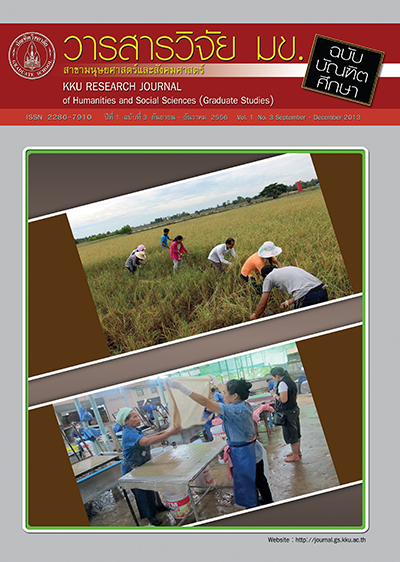การขยายความหมายของคำกริยา 看 kàn ในภาษาจีนกลาง(The Semantic Extension of Verb “kan” in Mandarin Chinese)
Keywords:
Metaphorical application to core meaning(กระบวนการอุปลักษณ์ที่ความหมายแก่น), Effect metonymy(กระบวนการนามนัยที่เน้นผลลัพธ์), Constituent metonymy(กระบวนการนามนัยที่เน้นส่วนประกอบย่อย)Abstract
บทความวิจัยนี้มีวัตถุประสงค์เพื่อวิเคราะห์การขยายความหมายของคำกริยา看 kàn “ดู” ในความหมาย “อ่าน” “เยี่ยมเยียน” “ตรวจรักษา” “สังเกตหรือตรวจสอบ” และ “คิดว่า” โดยใช้ทฤษฎีสี่ประเภทของคำหลาย ความหมายของไรเมอร์ (Riemer, 2006) [1] เพื่ออธิบายการเชื่อมโยงความสัมพันธ์ระหว่างความหมายพื้นฐาน กับความหมายที่ถูกขยายจากความหมายพื้นฐาน ผลการวิจัยพบว่า การขยายความหมายของคำกริยา看 kàn “ดู” ในภาษาจีนกลางในความหมาย “อ่าน” “เยี่ยมเยียน” “ตรวจรักษา” “สังเกตหรือตรวจสอบ” และ “คิดว่า” นั้น เกิดจากกระบวนการทางปริชาน 3 กระบวนการ คือ กระบวนการอุปลักษณ์ที่ความหมายแก่น กระบวนการนาม นัยที่เน้นผลลัพธ์และกระบวนการนามนัยที่เน้นส่วนประกอบย่อย
The purpose of this research is to analyze semantic extension of verb “kan” with the meanings of “READ”, “VISIT”, “TREAT”, “OBSERVED AND VERIFIED” and “THINK” , by using the four category theory of polysemy of Reimer (Riemer, 2006) [1]. For explain the relationship between basic meaning and its extended meanings. The results show that semantic extension of verb “kan” in Mandarin Chinese with the meanings of “READ”, “VISIT”, “TREAT”, “OBSERVED AND VERIFIED” and “THINK” are activated by three processes; metaphorical application to core meaning, effect metonymy and constituent metonymy.




